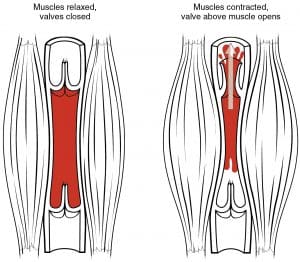Venous return is defined as the flow of blood back to the heart. It is therefore important in maintaining normal circulation. The heart is a myogenic pump, meaning it stimulates itself to pump blood. In order for the heart to pump blood, there needs to be an efficient system to bring back the low pressure, deoxygenated blood back to the heart from tissues.
This article will discuss factors which influence venous return.
Principles of Venous Pressure
Veins are blood vessels which carry blood back to the heart from organs. They are are low-pressure, low-resistance vessels compared to the high-pressure, high-resistance arteries.
The pressure in these veins (venous pressure) is the driving force for the filling of the heart. Venous pressure is affected by two parameters:
- The rate of blood entering the veins – this is linked to the peripheral resistance in the body.
When resistance is high, there is a slower rate of blood entering the veins, which decreases the venous pressure. Conversely, when resistance is low, blood enters the veins faster, which increases venous pressure.
- The rate at which the heart pumps out blood – this is linked to the cardiac output of the heart.
When cardiac output increases, blood is rapidly pumped out of veins, which reduces venous pressure (as it does not get a chance to rise). When cardiac output decreases, blood backs up into the venous system. Therefore, the blood volume increases which raises venous pressure.
Central Venous Pressure
Central venous pressure (CVP) is the blood pressure in the vena cava near the right atrium. Under normal circumstances, the CVP ranges from 2-6mmHg. CVP can be used as a proxy measure of the venous system.
Veins have high capacitance, which means they can distend with increasing blood pressure to hold a higher volume of blood and maintain the CVP. Additionally, veins have valves which act to maintain unidirectional flow of blood. The competency of these valves is important in maintaining venous return as they ensure blood is always flowing towards the heart.
There are various factors which can affect central venous pressure and thus venous return:
- Skeletal Muscle Pump – Peripheral veins often travel between muscles and use muscular contraction to increase venous return to the heart. When muscles (such as the quadriceps) contract (during walking, running, etc.), the vein is squeezed, increasing the venous pressure inside it. This forces the vein’s valves to open, allowing the blood to flow back to the heart to increase the venous return.

Fig 1 Skeletal muscle pump of the venous system
- Respiration – During inspiration, pressure in the thoracic cavity reduces due to chest expansion. This reduced intrathoracic pressure also reduces pressure in the right atrium, causing more blood to be drawn into it. This results in greater venous return.
- Venous Compliance – Increased sympathetic activity will reduce venous compliance as they . This increases the venous pressure and venous return as when blood flow into the veins increases, it cannot dilate to accommodate the increased blood. Instead, pressure in the veins rises and blood flow through the vessels increases to empty the veins faster.
- Gravity – Venous return often has to work against gravity to bring blood back to the heart, especially in the lower limbs. This can be reduced by lying down and elevating the legs, which increases venous return by reducing the effects of gravity.
- Blood Volume – The greater the blood volume in the veins, the greater the blood flow and venous pressure. The heart can accommodate the increase in blood volume because of the Frank-Starling mechanism (the greater the stretch, the greater the contractility of the heart).
- The Heart – The heart must be working efficiently to pump blood out of the veins and maintain venous return. Thus any problems in the heart’s ability to pump, such as heart failure, mean the blood does not
Clinical Relevance
Chronic Varicose Veins
In this condition, the competency of the valves in veins in compromised. This means the valves do not sufficiently close, allowing blood in the veins to flow backwards and accumulate in the veins. This can decrease the venous return.
This commonly affects the superficial veins of the legs, which look engorged and twisted. Blood can pool in the veins to cause bruising and ulceration of the tissue if the pressure becomes excessive.
Fig 2 – Diagram showing normal and varicose veins
Jugular Venous Pressure
The jugular venous pressure (JVP) is
